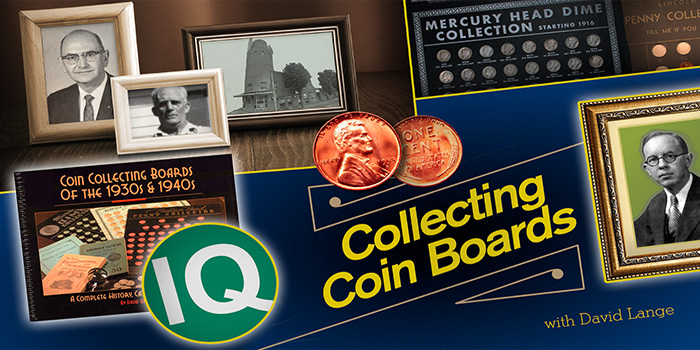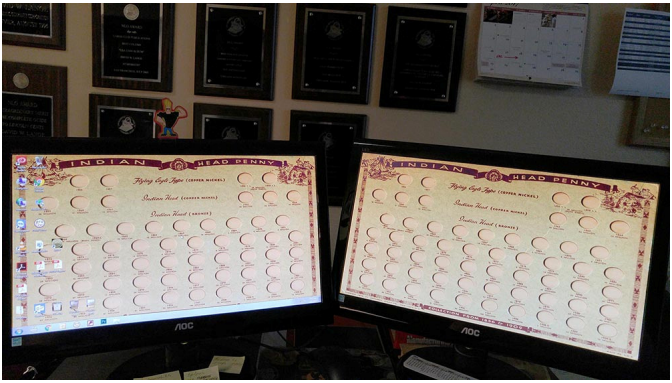
Antique Coin Boards with David W. Lange –
For Collectors of Antique Coin Boards
Number 50 — Spring 2019
IT’S BEEN A WILD RIDE…
Yes, I’m congratulating myself on 50 installments of Coin Board News.
Congratulations, too, to all of you who have followed it for the past 11 years. CBN Number 1 was a homely, colorless and unillustrated publication that couldn’t quite fill a single page! It has since grown to several pages featuring full-color photos of coin boards and associated ephemera. Many tales have been told, and many new board varieties have been chronicled within its pages. In celebration of this milestone, the current issue is expanded yet again and includes a feature article about Koinpanels, wooden coin boards produced from the 1950s into the early ’80s. Several examples are illustrated, courtesy of E & T Kointainer Company President Bernard A. Nagengast.
I closed the first issue of Coin Board News with the simple statement, “That’s what’s new in the world of coin board collecting,” and that mission of sharing the hobby continues today.
MARKET ACTIVITY
There were quite a few coin board listings on eBay during the past quarter, though some of these were overpriced rollovers from previous months. One lot of note featured no fewer than 10 boards, though all but two were common Second or Third Edition Whitmans. The two standouts were a First Edition Whitman board for Indian Cents displaying the very scarce green backing and a 1938 first printing of the Oberwise board for Lincoln Cents. These brought $71 plus $15 shipping, which was neither bargain nor burial. I did manage to acquire for inventory two examples of the scarce Whitman board for Liberty Standing Half Dollars. The Second Edition board was in so-so condition, but the price was right. The far more scarce Third Edition board was quite clean, and it went quickly to fulfill someone’s want list.
By far the most important board sales were for three Lincoln Printing Company titles in very nice condition and bearing either printed labels or vendor stamps for coin dealer Maurice Scharlack. His sister Jean was married to Robert Ritterband, owner of Lincoln Printing Company, and this historical association made me eager to acquire at least one of the three.
As is so often the case, however, I was the frustrated underbidder on all three, and there’s no telling how much the winner actually bid. The Indian Cent board realized $96, the Lincoln Cent $86, and the Buffalo Nickel $83. I’m certain that the latter would have brought more had it not been the first of the three offered; my opponent and I had not yet established each other’s determination!
BOOK UPDATES
The only new board variety this quarter is O5ȼAl, reported by reader Joe Webster. I’ve produced a complete Check List and Value Guide for all of the items found in my book Coin Collecting Albums: A Complete History and Catalog, Volume Two. This includes all Library of Coins and Treasury of Coins albums in three grades, and it’s available for free in PDF format by emailing me.
ON THE ROAD AGAIN?
Well, no. My chemotherapy is set to run into early June, and I won’t be traveling at all during that time. Sadly, I’ve had to cancel my annual gig as an instructor at the American Numismatic Association’s Summer Seminar. Nevertheless, I fully expect to return to the coin show circuit this summer.
THE KURIOUS KOINPANEL
Bernard A. Nagengast contacted me recently to inquire whether I’d like to publish his history of a coin board he manufactured and sold during the 1980s under the name Koinpanel. This immediately stirred a memory from that time when I actually purchased a Koinpanel from his E & T Kointainer Company to house my set of Kennedy Half Dollars. I’d transferred all of my modern coins into Kointains, which are inert, clear plastic lenses that friction fit over the obverse and reverse of a coin. These could then be inserted into the openings of the Koinpanel, resulting in a coin board that permitted viewing both sides of the coins.
Needless to say, I welcomed his reminiscences about the company and its products. Too long to reprint in its entirety, I’m including here my summary of the main points:
In the late 1940s, a collector named Francis S. Epps noticed that some of his coins were deteriorating due to the primitive state of coin storage products at the time, and he set about finding a solution. Consulting with a research chemist named Trainer (spelling uncertain), he selected ethyl cellulose as the ideal plastic for chemical inertness and malleability. The end product was the “Kointain”, a two-piece capsule that was convex so as to not contact the coin except on its edge. E & T Kointainer Company was established in 1950, and ultimately holders of many sizes were offered.
Epps bought out his partner and continued the business until his death in 1973. Bernard “Bern” Nagengast purchased the rights five years later and has operated the company ever since. It still manufactures and sells the Kointain capsules.
Francis Epps sought a display product for his Kointains and came up with a hardwood veneer plywood board with openings cut to fit various sizes of coins. The Koinpanel debuted in 1952 in a standard size of 8″ wide x 6″ tall x 3/16″ thick. African Mahogany was the default wood, but Rosewood was available at a higher price. These were drilled and labeled in gold-colored hot type for various coin denominations, and a smaller 8″ x 3″ Koinpanel was added for proof or mint sets.
When Bern Nagengast purchased the company from Epps’ successors, he acquired a large back inventory of these panels, which had enjoyed only limited sales over the years. Collectors suggested to him that a larger format Koinpanel that could hold all or part of a coin series would be much more desirable, and he set about to produce such an item. He discovered that the woods used by Epps were either unavailable or unaffordable, but he found a suitable replacement in Honduran Mahogany. The new Koinpanel measured 8″ wide by 12″ tall.
The decision was made to start with the most popular coin series–cents back to 1857, nickels back to 1883, silver coins back to 1892, etc. To reduce the number of different die cuts, he settled on eight-panel arrangements. He had the drilling equipment from Epps to cut the openings, but hot type had become obsolete, so he sought a new lettering/numbering technique. The simple solution was the dry transfer type sold by stationery stores. He custom ordered 2,000 sheets that included every combination of titles, dates, mints, etc. that he anticipated would be needed.
The new Koinpanel line debuted in 1982, but it was destined to last only a year or so. Production was labor intensive, sales were disappointing, and collectors sometimes complained that the Kointains were difficult to insert into the openings. Indeed, I found this to be true of my Kennedy Half Dollar panel, and I declined to order any more Koinpanels. Bern Nagengast estimates that only 100 or so of the new Koinpanels were sold in that time.
Obviously, this is a very rare entry in coin board history, and I sorely regret not having saved for posterity my one and only purchase. Bern discarded most of the company’s inventory years ago, but he graciously sent me a few of the original Epps Koinpanels for my collection along with associated literature.
Best Regards,
—David W. Lange

The author’s desktop, featuring Gramercy coin boards as his computer wallpaper. Photo courtesy David W. Lange




